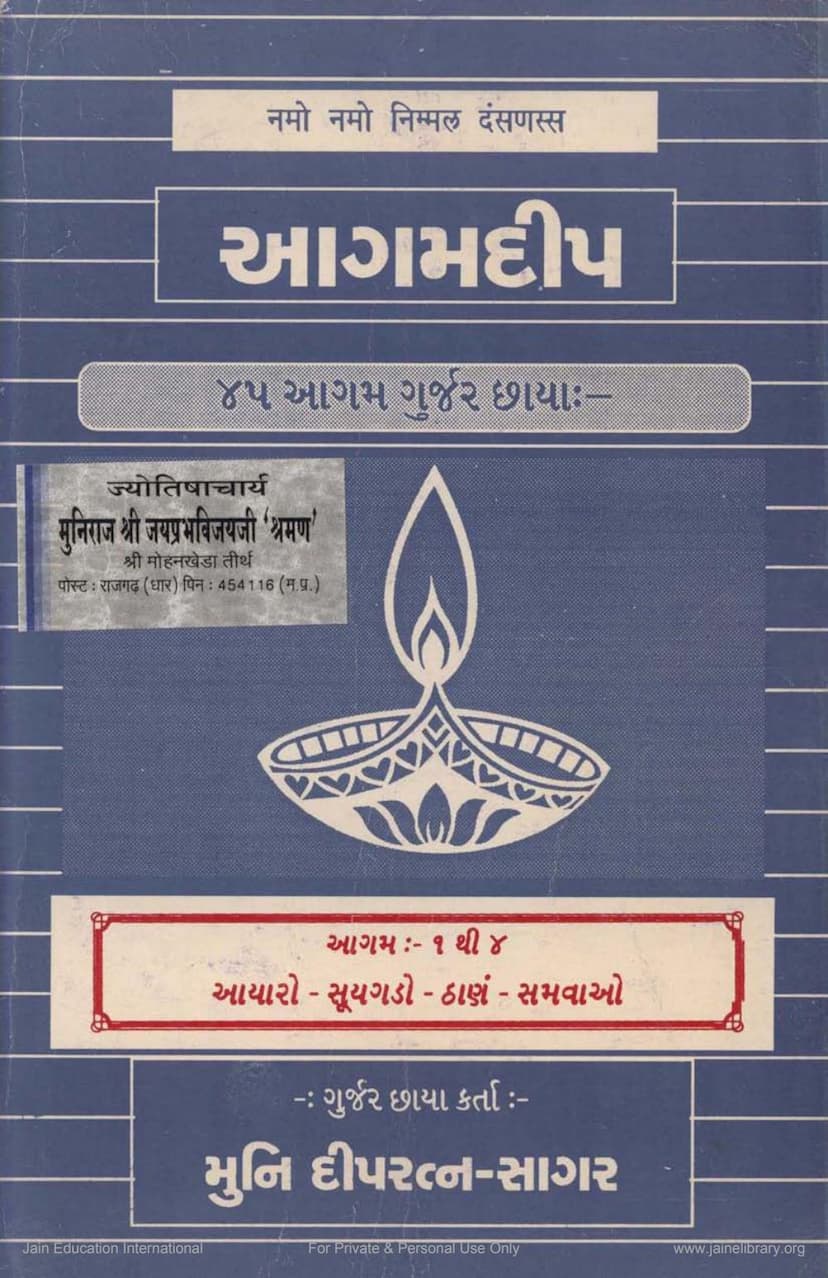Agam Deep 21 Puffiyanam Gujarati Anuvaad
Added to library: September 1, 2025

Summary
This document is a Gujarati translation and commentary titled "Agam Deep 21: Pushiyanan Gujarati Anuvaad" by Muni Dipparatnasagar, published by Agam Shrut Prakashan. The catalog link indicates it focuses on the 21st Upanga Sutra within the Jain Agamas.
Here's a summary of the provided pages, focusing on the content related to the Pushiyanan Sutra:
Overall Purpose: The "Agam Deep" series aims to provide a comprehensive explanation and translation of Jain Agamas in Gujarati. This particular volume, "Pushiyanan Gujarati Anuvaad," focuses on the Pushiyanan Sutra, which is the 21st Upanga Sutra. The text includes a "Gurjar Chhaya" (Gujarati commentary/explanation) by Muni Dipparatnasagar.
Key Information and Content:
- Title and Author: Agam Deep 21 Pushiyanan Gujarati Anuvaad, by Muni Dipparatnasagar.
- Publisher: Agam Shrut Prakashan.
- Scope: The document covers the Pushiyanan Sutra, which is identified as the 10th Upanga Sutra (Page 11, 20, 22, 23, 25, 26). It also lists the entire sequence of Upanga Sutras from 1 to 21 (Pages 8-10).
- Structure of the Commentary: The text provides a detailed breakdown of the Pushiyanan Sutra, focusing on its various "Adhyayans" (chapters/sections). Specifically, it covers Adhyayan 1 (Chandra), Adhyayan 2 (Surya), Adhyayan 3 (Shukra), Adhyayan 4 (Bahupatrika), Adhyayan 5 (Purnabhadra), and Adhyayan 6 (Manibhadra), and mentions Adhyayans 7-10 (Shiva, Val, Anadhia).
- Content of the Adhyayans:
- Each Adhyayan begins with a question from Gautam Swami to Lord Mahavir about the meaning of that particular section.
- The commentary then recounts the celestial beings associated with the specific celestial body or concept (e.g., Chandra, Surya, Shukra).
- It details their celestial abode, their presence, and their activities.
- Crucially, it delves into the past lives (Pūrvabhava) of these celestial beings. These past lives are described with details of their earthly existence, their actions, their association with Tirthankaras (like Parshvanath and Mahavir), and the karma that led to their current celestial birth.
- The narrative often highlights the consequences of good deeds (like devotion, adherence to vows) and negative actions (like attachment, misinterpretations of dharma, disrespect).
- Examples from the text:
- Adhyayan 1 (Chandra): Describes Chandra, a celestial king, and his past life as Angati, a householder who took diksha from Lord Parshvanath, committed an error in his conduct, and was reborn as Chandra. The commentary traces his journey and future destiny.
- Adhyayan 2 (Surya): Similar to Chandra, this Adhyayan discusses the celestial being Surya and his past life as Supratishthit, another householder who also took diksha from Lord Parshvanath and faced a similar karmic journey.
- Adhyayan 3 (Shukra): Details the celestial being Shukra and his past life as Somil, a Brahmin who initially followed Jain principles but later strayed due to attachment and misinterpretations, leading to his rebirth as Shukra. The narrative emphasizes the importance of correct understanding of dharma and the consequences of deviation.
- Adhyayan 4 (Bahupatrika): Focuses on the celestial being Bahupatrika, detailing her past life as Subhadra, a householder who desired children, encountered Sadhvis, embraced Shravak dharma, but then fell into undesirable conduct due to attachment to children, leading to her karmic destiny. This Adhyayan extensively discusses the challenges and consequences of worldly attachments and the importance of true spiritual practice.
- Adhyayan 5 (Purnabhadra): Discusses the celestial being Purnabhadra and his past life as Purnabhadra, a householder who took diksha from a Stavir Muni, practiced austerities, and attained his celestial state.
- Adhyayan 6 (Manibhadra): Covers the celestial being Manibhadra and his past life as Manibhadra, a householder who similarly took diksha and practiced austerities.
- Moral and Spiritual Lessons: The commentaries consistently highlight the principles of karma, the impermanence of worldly existence, the importance of right faith and conduct, the dangers of attachment and delusion, and the ultimate path to liberation through right knowledge, right faith, and right conduct.
- Sponsorship and Support: The text gratefully acknowledges various donors and individuals who supported the publication, indicating a community effort in making Jain scriptures accessible (Pages 3, 5, 6).
- Other Publications: Page 7 lists other publications by the same publisher, showcasing a broad range of Jain literature.
In essence, the "Agam Deep 21: Pushiyanan Gujarati Anuvaad" is a scholarly work that makes the complex teachings of the Pushiyanan Sutra accessible to Gujarati-speaking readers. It meticulously translates and explains the dialogues between Lord Mahavir and Gautam Swami, focusing on the karmic journeys and past lives of celestial beings, thereby illustrating fundamental Jain philosophical concepts.